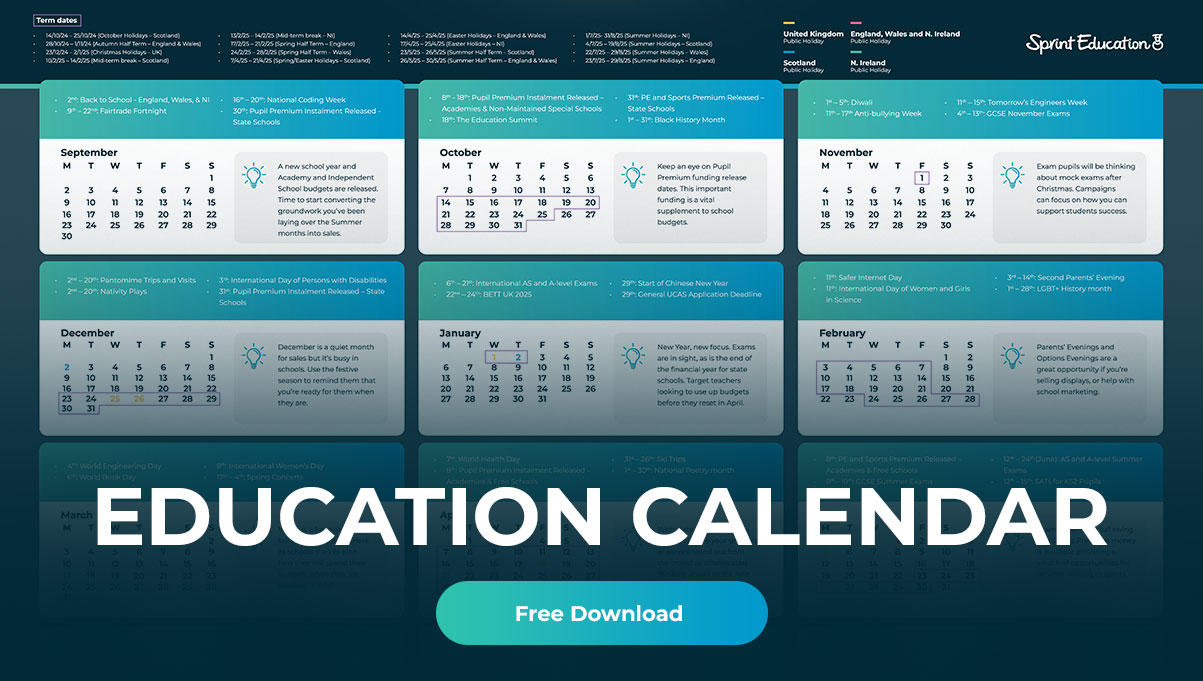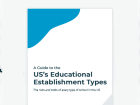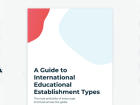A Guide to the US’s Educational Establishment Types
A Guide to the US’s Educational Establishment Types
Learn exactly who you're selling to with your schools marketing with our breakdown of every educational establishment across the US.
Learn exactly who you're selling to with your schools marketing with our breakdown of every educational establishment across the US.
Regular School
In the United States, the largest percentage of students are educated at Public Schools – elementary, middle, and high schools funded and/or run by a government entity, who provide most of the funding and administrative oversight. Approximately 87% of school-age children attend state-funded public schools, 10% attend private schools, and 3% are home-educated.
In the US, children must start school between the ages of 5 and 8 (depending on the state) and must remain in education until they reach an age of 14 to 18 (once again, state-dependant). It’s not uncommon for gifted and talented students to move up through each grade earlier than the typical age.
The bulk of the $1.3 billion education funding for US schools comes from state and local governments, with Federal funding accounting for approximately only $200 billion. The Federal government does not hold direct authority over the country’s education system, although they do hold a few key responsibilities such as administering Federal assistance programmes, enforcing civil rights laws, and publishing education data. Instead, states and local communities are responsible for the educational institutions in their district.
State governments are responsible for the direct oversight of the schools in their states, with general responsibilities including providing funding, chartering schools, providing guidance to local school boards, and electing governing board members.
Local school boards are responsible for the actual, day-to-day operation of the schools, including hiring and managing staff, developing and implementing education policies, and implementing and enforcing state laws and policies.
Special Education School
Special Education in US schools enables students with additional learning needs to access resources through special education programmes. Such programmes were made mandatory in 1975 in an Act passed by Congress that requires all states to provide ‘special education and related services consistent with deferral standards as a condition of receiving federal funds’.
The Individuals with Disabilities Education Act entitles every student to free and appropriate public education through their local school district. As of 2017, approximately 13% of US students receive these services. Some students may access this through mainstream state education, but others may be enrolled in a Special Education School.
Special Education Schools provide individualised education to address students’ specific needs, and facilities such as sensory rooms or swimming pools to support students with additional needs. Student to staff ratios are kept low (usually 6:1 or lower) to allow for more one-on-one time and specialised support.
The state and local government hold primary responsibility for education in Special Education Schools, whether they’re tax-funded public schools or privately funded private schools. Public Special Education Schools are funded through a combination of local, state, and federal government funding. Each state will have its own funding allocation mechanism, but the most common model for distributing special education funding to districts is through the ‘multiple student weight’ system, whereby students are assigned funding amounts based on their disability, its severity, or the level of support and resources they require.
Career and Technical School
Funding for vocational education has been available to US schools since 1917, and, as of 2017, 98% of public school districts are offering Career and Technical Education programmes to high school students.
Career and Technical Schools, also known as trade schools, go a step above, providing full post-secondary Career and Technical Education to students after graduating from high school or obtaining their GEDs. These schools allow students to earn certificates, degrees, and diplomas in sixteen career tracks, including automotive, hairstyling, computing, mechanical, and more. All schools offer a one-year certificate or two-year degree, and a high-skilled, hands-on learning experience.
These types of schools are an alternative to the traditional college route, and are often more affordable, with average tuition fees varying from roughly $3,000 to $15,000. With half of college students (57%) agreeing that higher education is no longer “worth the cost”, it’s no wonder trade and technical school market growth has reached $16 billion.
Some governments are trialling Career and Technical Education as an alternative to standard high schools to support students with low levels of engagement or attendance, funded by local school districts or charter school.
Most states have laws requiring that Career and Technical Schools are licenced to offer instructional courses.
Alternative Education School
Alternative Education Schools provide a non-traditional education to their students, comprised of many pedagogical approaches different to the mainstream approach. They have sharply grown in popularity in the US since the 1970s.
Some schools will have strong political, scholarly, or philosophical orientations, while others may be set up to meet the needs of specific groups of students, such as those who are gifted and talented, those with special educational needs, or those who have been excluded from regular schooling. Some are simply ad-hoc groups of teachers and students unsatisfied with aspects of traditional schooling.
While Alternative Education Schools will differ in structure and purpose, they all have many of the same characteristics, such as smaller class sizes, individualised approaches to teaching, experiential learning applicable to life outside school, and a greater integration of children of different ability and socio-economic status.
Funding patterns at the Federal level make it difficult for Alternative Education Schools to find readily available, sustainable funding – programme providers must seek out federal funding streams and fit them into existing interventions, or change their interventions to accommodate the goals of the Federal programme.
District
In the US, most K-12 public schools function as units of local school districts, based on geographical area. These districts usually operate several schools, with the largest districts operating hundreds. The practice varies significantly from state to state (and in some cases within the state itself), but most districts run as independent local government units under a grant of authority, and within geographical limits governed by state law.
Executive and legislative power of policies and operations of a public school district are usually held by the district’s board of education. This board is at the top of the organisational hierarchy, responsible for providing oversight and governance for the district and all of its schools. Below the board is the superintendent, followed by executive officials and assistant superintendents, then the schools’ principals.
School districts in the Midwest and West tend to cross municipal boundaries, while districts in New England and the Mid-Atlantic regions tend to adhere to city, township, and/or county boundaries. In most southern states, school systems operate either as an arm of county government, or at least share coextensive boundaries with the state’s counties.
There are approximately 14,000 public school districts across all states, with an average student population of around 5,000, educating approximately 55.2 million students overall.
Regular Public School District
A Regular Public School District is a local government administrative authority which governs the education system at a specified local level on behalf of the public and the state.
These districts are authorised by the state, either directly or through delegated authority, and governed in accordance with state statute – a publicly elected school board, for instance.
Regular Public School Districts are intended to design and develop education standards and goals, including curriculum to support state and government guidelines for education, and hold primary responsibility for providing public education. Funding for schools included in the district will stem from federal, state, and local sources; procured and allocated by the district.
There are two types of Regular Public School District – those that are a component of a supervisory union, and those that aren’t. Local supervisory unions are administrative, planning, and educational service units created by the State Board of Education, and provide management services for a group of associated school districts.
Supervisory Union Administrative Center
Supervisory Union Administrative Centers act as an administrative, planning, and educational service unit for two or more districts, created by the State Board. They were established in the New England area, as these states were in a weaker political position, and exist, in large, to share superintendents between school districts.
Supervisory Unions have many similarities to the UK Multi-Academy Trust; they’re responsible for the education of students across every school in their union, and maintaining and running each school in order to facilitate great personal and academic outcomes.
Supervisory Unions are governed by Board representatives appointed from members of each school district’s board. This board adopts a state budget, included in each school district’s budget, and allocates it among the member school districts. The State Board of Education holds the authority to adjust the boundaries of a Supervisory Union on its own initiative, or at the request of a school district.
Service Agency
An Education Service Agency is a regional public multiservice agency authorised by state law to develop, manage, and provide services or programmes to local education agencies, such as public-school districts.
The Service Agency will oversee the instruction and educational services of students in a particular setting, such as a geographical area. They’re responsible for setting standards for all schools within their setting, and may audit schools, set budgets, and provide an extra channel of communication for parents and carers who wish to raise a concern. They may also be responsible for, in part, allocating the funding each school district receives, and providing resources that districts may not be able to afford on their own – particularly vital for rural states where tax revenue and student numbers cannot support specialised equipment and services in each district.
Funding for Service Agencies will come from a variety of sources. Local property taxes can make up a great percentage of the funding, and most agencies also receive money both directly and indirectly from state and federal sources.
A local education agency is sometimes known as a school district, but other organisations may also be considered to be Service Agencies. Individual districts are responsible for the operation of elementary, middle, and high schools, and many are also responsible for the provision of special education programmes. These Service Agencies are usually lead by a superintendent, who must answer to a local board of directors.
State Agency
A State Agency, or State Department of Education, is the state-level government organisation responsible for education, including providing information, resources, and technical assistance on educational matters to all schools in the district, both public and private, and the wider community.
Originally designed to administer state and federal education programmes, shifts at state and federal levels have now assigned these agencies roles as architects and implementers of key education policies.
All agencies across the US are united in their same goal of ensuring outstanding learning outcomes. But, as different states provide differing political and historical context, funding levels, and staff capacity, the state-by-state approach will differ.
State Agencies hold a huge variety of roles and responsibilities, with a few examples being:
- Creating a vision, priorities, and goals for K-12 education in the state.
- Administering state and federal funds and programmes in accordance with their strategy.
- Maintaining data to support a focus on achievement, equality, and progress.
- Improving the quality of teacher education, and establishing HE partnerships to do so.
- Publishing data, including achievement and attainment on a school, district, and state level
Federal Agency
The U.S. Department of Education is the agency of the federal government that establishes policies for, and administers and coordinates most federal assistance to education. The Federal Agency will assist the president in executing their education policies for the nation, and implementing Congress laws.
The Department ’s mission is to facilitate educational excellence, promote student achievement, and ensure equal access. Responsibilities are many and varied, but include the following:
- To strengthen the Federal commitment to ensure equal education opportunities for every student.
- To support the efforts of States, schools, institutions, families, and more to improve the quality of education.
- To improve and encourage involvement in Federal education programmes.
- To improve the management and efficiency of Federal education activities.
Other Federal Agencies do have some, far smaller, involvement in education. For instance, the United States Department of Agriculture runs The Research, Education, and Economics mission to advance scientific knowledge of agriculture through research, extension, and education. This Agency would work with the U.S. Department of Education to create and support the delivery of agricultural education programmes.
Independent Charter District
An Independent Charter District is an education unit created under the state charter legislation that’s not under the administrative control of another local education agency, and that operates one or more charter schools.
Charter Schools are publicly financed on a per-pupil basis, but independently run, and free of tuition. They have much more freedom than traditional public schools in terms of schooling, staffing, and most other aspects of education, but are held to public and market countability and can be stripped of their charter status.
Only Charter Schools can be part of the Independent Charter District. Within these districts, the local board will have decided not to directly operate any schools themselves, but to work through independent groups. Rather than employing large numbers of staff, an Independent Charter District will employ contractors for each school (or to share between a few schools) to be responsible for teaching, hiring, finances, and administration.
Charter Districts have the ability to pool resources along with contractors, benefitting all schools in the district, not only those that are underperforming.
Other Education Agency
In the US, most Education Agencies are school districts or agencies administered by the department of development disabilities. However, there are joint vocational school districts, departments, offices, boards, or other state or local agencies that also form Education Agencies. In many cases, these agencies provide special education or related services to children with disabilities.
Specialized Public School District
A Specialized Public School District is a school district that operates one or more schools designed for a specific educational need or purpose. For example, these could be districts comprised of only vocational or special education schools.
These districts design and develop education standards and goals, including curriculum for a specific need or purpose; and procure and allocate funding from federal, state, and local sources for schools and other education services. They may be authorised to provide credentials, such as vocational education certificates, and specialist education services to other education agencies.
Specialized Public School Districts are state-authorised (either directly or through delegated authority) and are governed in accordance with state statute – e.g. publicly elected school boards.
What Next?
There you go – a brief run-down of all 12 US school types you can market to in Campus. But there’s no time to waste – those 12 school types equate to hundreds of thousands of schools and teachers all waiting to hear from you!
When you’re ready to reach out to them, plus learn more about which schools your business must be emailing, get in touch on info@sprint-education.co.uk or 01684 297373 for a walkthrough of Campus.
Tags
Database of Schools
Education Data
Education Database
Schools Database
Similar Articles


School Funding Made Simple
What You Need to Know to Make More Sales This Year!

The Unstoppable Rise of MATs
Learn how Multi-Academy Trusts now dominate much of the education purchasing landscape - and why their incredible growth is good news for your edu-sales...


Expert marketing to schools support and solutions
Expert marketing to schools solutions
Email Head Teachers, Teachers, and Staff Inboxes
Email teachers and staff inboxes
Sell More to UK and Global Schools and Colleges
Sell more to schools and colleges
































